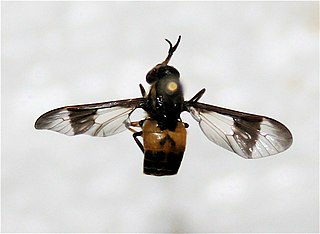
Stonemyia is a genus of flies in the family Tabanidae.

Osca lata, the coliguacho or black horse fly, is a large horse fly whose range includes southern Chile and southern Argentina. The fly has a striking reddish-orange coloration on the side of its thorax and abdomen. It is generally around 2 cm. in adult size.

Diachlorus ferrugatus, commonly known as the yellow fly in the United States or doctor fly in Belize, is a species of highly aggressive biting horse-fly of the family Tabanidae native to North and Central America to Costa Rica.

Tabaninae is a subfamily in the family Tabanidae commonly known as horse flies. There are more than 3000 described species in Tabaninae.

Diachlorini is a tribe of horse flies in the family Tabanidae.

Atylotus is a genus of horse flies in the family Tabanidae.
Chrysops lateralis is a species of deer fly in the family Tabanidae.

Chrysopsinae is an insect subfamily in the family Tabanidae commonly known as deer flies or sheep flies and are bloodsucking insects considered pests to humans and cattle. They are large flies with large brightly-coloured compound eyes, and large clear wings with dark bands. They are larger than the common housefly and smaller than the horse-fly.

Chrysops geminatus is a species of deer fly in the family Tabanidae.
Agkistrocerus is a genus of horse flies in the family Tabanidae.
Tabanus turbidus is a species of horse fly in the family Tabanidae.
Tabanus marginalis is a species of horse fly in the family Tabanidae.
Tabanus abdominalis is a species of horse fly in the family Tabanidae.
Stonemyia isabellina, is a species of fly in the family Tabanidae.
Agkistrocerus megerlei is a species of horse flies in the family Tabanidae.

Tabanus sulcifrons is a species of horse fly in the family Tabanidae.
Hybomitra difficilis is a species of horse flies in the family Tabanidae.
Stenotabanus is a genus of horse flies in the family Tabanidae. There are at least 100 described species in Stenotabanus.
Pangonius mauritanus is a species of horse fly in the family Tabanidae.
Bouvieromyiini is a tribe of horse flies in the family Tabanidae.









